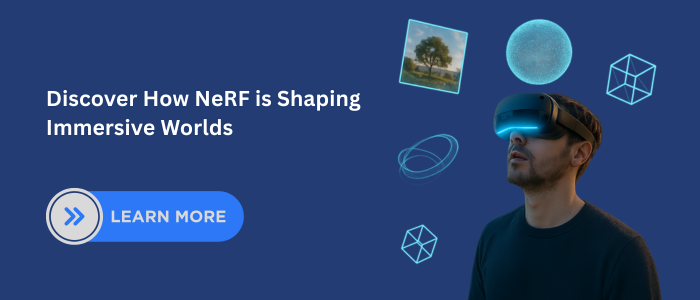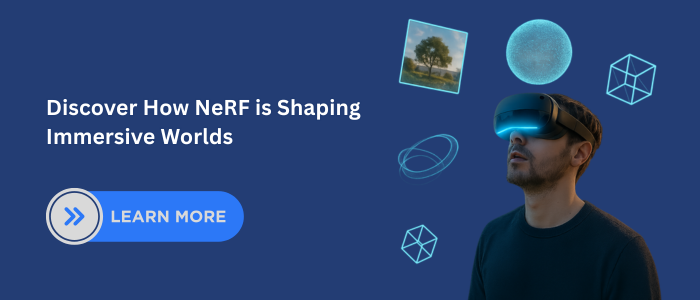Introduction
In the era of artificial intelligence (AI), computer vision, and immersive technologies, one breakthrough is gaining rapid traction: Neural Radiance Fields (NeRF). This cutting-edge technique allows us to reconstruct realistic 3D scenes from ordinary 2D images, opening the door to new possibilities in AR/VR, gaming, e-commerce, sports analytics, manufacturing, and even agriculture.
Unlike traditional 3D modeling or photogrammetry, NeRF leverages deep learning to create photorealistic and dynamic 3D environments with unmatched accuracy. Tech giants, startups, and research labs are already adopting NeRF to revolutionize how we experience digital content.
In this guide, we’ll break down everything you need to know:
What NeRF is and how it works.
The workflow from image capture to 3D model generation.
Popular NeRF variants like Instant-NGP and Gaussian Splatting.
Training tips, performance considerations, and deployment strategies.
Real-world business applications and case studies.
Ethical concerns and best practices.
Whether you’re a developer, business owner, or AI enthusiast, this blog will serve as your comprehensive NeRF tutorial and practical roadmap.
What is a Neural Radiance Field (NeRF)?
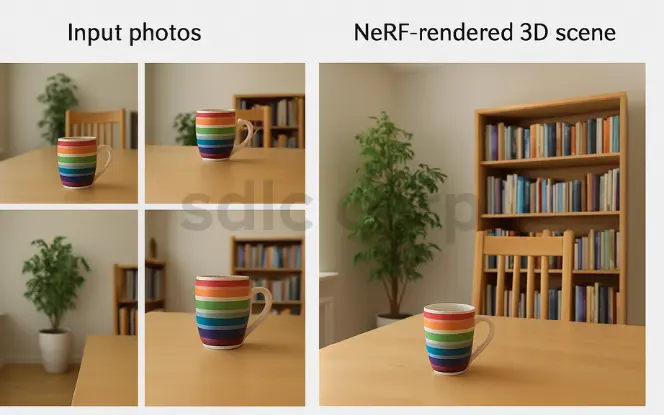
A Neural Radiance Field (NeRF) is an AI model that generates a 3D representation of a scene from multiple 2D images. It works by using deep learning to understand how light travels through a scene, allowing it to reconstruct photorealistic 3D views from any angle.
Unlike traditional methods, NeRF doesn’t require detailed 3D scans it learns from image datasets and produces a highly accurate volumetric scene.
Related Reading: How Do AI and Algorithms Differ from Each Other?
How Do Neural Radiance Fields Work?

At its core, NeRF maps 3D space into a neural network that models color and density at every point. It then simulates how light rays pass through the scene to produce realistic images.
Step-by-Step Workflow
- Data Collection
Capture multiple 2D images of a scene from different angles.
Metadata like camera position and orientation is crucial.
Neural Network Training
The model learns how light rays interact with surfaces.
It maps each point in 3D space to its density and radiance (color + brightness).
Scene Reconstruction
By sampling rays across the scene, the network can reconstruct how it looks from novel viewpoints.
Rendering
The trained NeRF generates photorealistic 3D views often indistinguishable from real photographs.
This makes NeRF especially powerful for industries like gaming, AR/VR, and product visualization where immersive realism is critical
Key Variants Of Neural Radiance
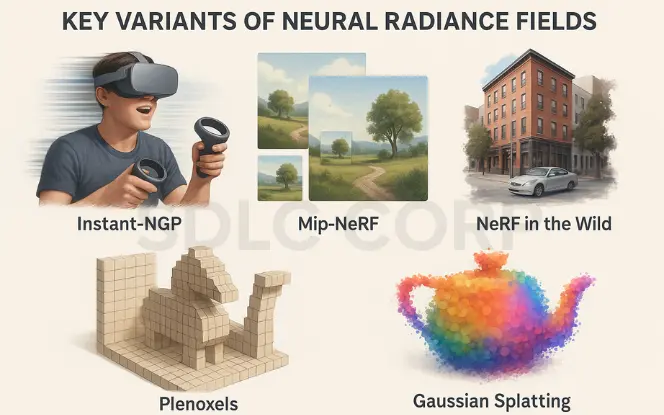
Since its introduction in 2020, several NeRF variants have emerged, each solving specific challenges.
1. Instant-NGP (Neural Graphics Primitives)
- Developed by NVIDIA, this enables real-time NeRF rendering.
Critical for AR/VR and gaming where latency must be minimal.
2. Mip-NeRF
Optimized for scenes at different levels of detail.
Produces smoother transitions when zooming in/out.
3. NeRF in the Wild (NeRF-W)
Handles unconstrained, real-world datasets with inconsistent lighting or incomplete data.
Useful for outdoor scenes and dynamic environments.
4. Plenoxels
A faster, grid-based alternative to NeRF.
Sacrifices some realism for training efficiency.
5. Gaussian Splatting
A newer competitor to NeRF.
Uses point-based rendering for faster processing.
📌 Related Reading: Top 5 AI and ML Trends Reshaping the Future
Training NeRF Models: Challenges and Best Practices

Challenges
Compute-Intensive: Requires powerful GPUs (e.g., NVIDIA RTX 3090+).
Time-Consuming: Training can take hours to days depending on dataset size.
Data Hungry: NeRF needs multiple high-quality images for accuracy.
Storage Issues: Large datasets consume significant storage.
Best Practices
- Use Instant-NGP or pre-trained models to cut training times.
Clean and normalize datasets to reduce artifacts.
Apply data augmentation for robustness.
Regularly benchmark results against ground-truth images.
Real-World Applications of NeRF
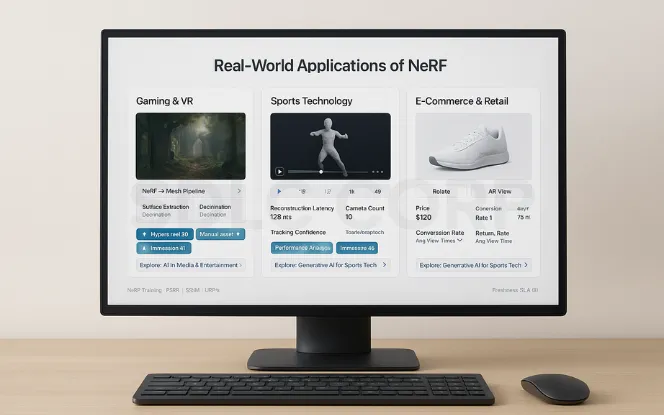
NeRF isn’t just a research novelty it’s powering real-world applications across industries.
1. Gaming and Virtual Reality
Creates hyper-realistic 3D environments.
Reduces manual labor in asset creation.
- Improves player immersion in open-world games.
Explore: AI in Media and Entertainment
2. Sports Technology
Enables 3D replay systems for performance analysis.
- Enhances fan engagement through immersive AR stadiums.
Explore: Generative AI for Sports Tech
3. E-Commerce and Retail
Shoppers can view products in 3D, rotate them, and even visualize them in real environments.
Increases conversion rates by reducing uncertainty.
4. Manufacturing and Startups
Speeds up digital twin creation for simulations.
- Aids in rapid prototyping of new products.
5. Agriculture
Farmers can generate 3D terrain maps for precision farming.
- Useful for crop monitoring and yield forecasting.
Explore: AI for Agriculture
6. Social Impact Organizations
Helps with environmental monitoring and cultural preservation.
- NGOs can reconstruct historical sites for education and awareness.
Explore: Generative AI for Social Impact
NeRF vs. Other 3D Reconstruction Methods
| Feature | NeRF | Photogrammetry | 3D Scanning |
|---|---|---|---|
| Input Data | 2D images | 2D images | Laser scans |
| Accuracy | High | Medium | Very High |
| Speed | Moderate (fast with Instant-NGP) | High | Low |
| Cost | Moderate | Low | Very High |
| Output Quality | Photorealistic | Decent | Precise geometry |
NeRF strikes a balance between accuracy, cost, and scalability, making it attractive for businesses.
Ethical and Practical Considerations
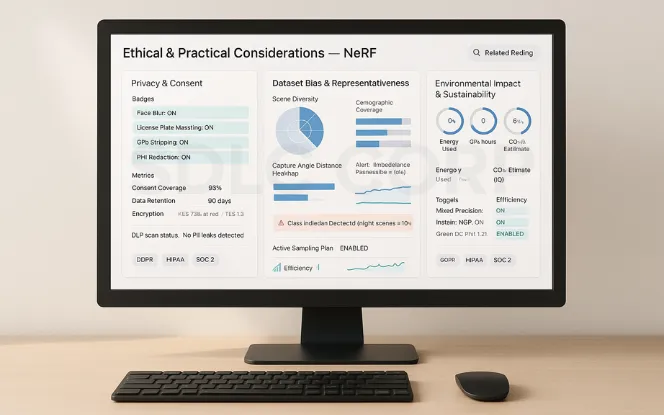
While NeRF is promising, businesses must address key issues:
Privacy Concerns: Capturing real-world data may expose personal information.
Dataset Bias: Non-diverse data can lead to skewed results.
Environmental Impact: Training requires significant energy, contributing to carbon emissions.
Related Reading: AI & ML Implementation Services
The Future of NeRF
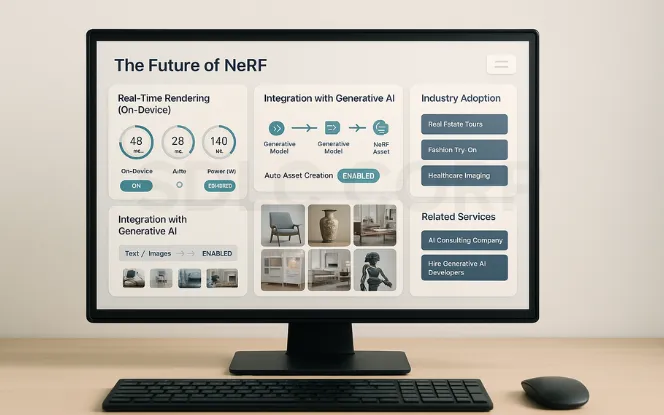
The technology is still evolving, but several trends stand out:
Real-Time Rendering: Future NeRFs will run on consumer devices.
Integration with Generative AI: Automatically creating assets for games, films, and e-commerce.
Industry Adoption: Expect NeRF in real estate tours, fashion, healthcare, and robotics.
Related Services: AI Consulting Company | Hire Generative AI Developers
Costs and Technical Requirements
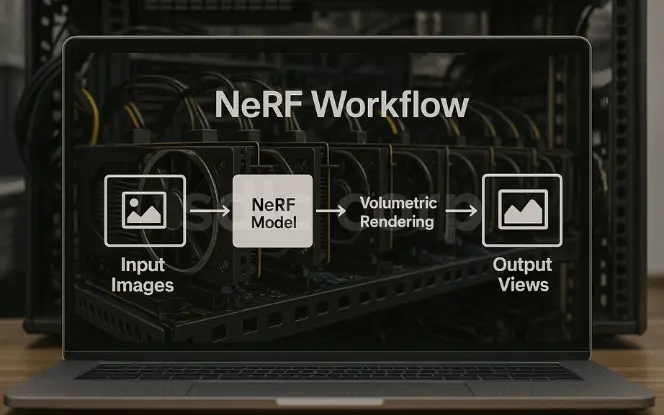
Implementing NeRFs involves:
- Hardware: GPUs with high memory bandwidth (e.g., NVIDIA RTX).
- Software: PyTorch, TensorFlow, specialized NeRF frameworks.
- Storage: Large datasets for training.
Energy Costs: Intensive compute requirements.
Ethical and Practical Considerations

- Privacy: 3D reconstructions from photos raise privacy issues.
- Misuse: Potential for deepfake-like manipulations.
- Accessibility: High compute cost limits smaller developers.
- Sustainability: Energy consumption of large-scale NeRFs.
Conclusion
Neural Radiance Fields (NeRF) represent a paradigm shift in 3D scene reconstruction. From entertainment and retail to manufacturing and agriculture, NeRF opens new possibilities for businesses looking to create immersive, interactive, and photorealistic experiences.
By embracing NeRF, companies can gain a competitive advantage in AI innovation, reduce costs in 3D content creation, and deliver richer digital experiences.
The future is clear: NeRF will be at the center of how we visualize, interact, and engage with the digital world.
FAQs
What is a NeRF?
A deep learning model for 3D scene reconstruction.
How is NeRF different from traditional 3D modeling?
It learns volumetric scene representation instead of relying on manual meshes.
Can NeRFs run in real-time?
Yes, with NVIDIA Instant NeRF and other advances.
What industries benefit most from NeRFs?
Gaming, AR/VR, robotics, architecture, and cultural preservation.
Are NeRFs resource-intensive?
Yes, but optimizations are reducing hardware needs.


